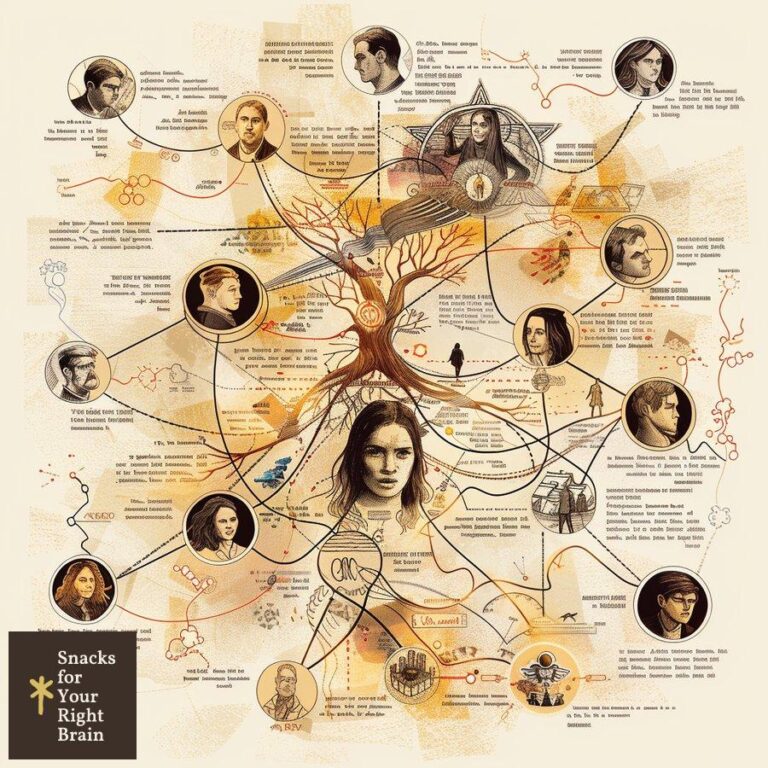What Do Character-Driven Stories Focus On
What defines a character-driven story?
Character-driven stories prioritize the development and evolution of characters over external events or plot twists. These narratives focus on the inner lives of characters, exploring their motivations, desires, and conflicts, which often leads to a more profound emotional experience for the reader. Unlike plot-driven stories, where the action often takes precedence, character-driven narratives invite readers to connect with characters on a personal level.
Characteristics of Character-Driven Stories
-
Focus on Inner Conflict: The primary tension arises from the characters’ internal struggles rather than external obstacles. This allows readers to witness the characters’ growth and transformation.
-
Complex Characters: Characters in these stories are multi-dimensional, with strengths, weaknesses, and intricate backstories. They often face moral dilemmas that challenge their beliefs and values.
-
Emotional Depth: The emotional journeys of characters are central to the narrative. Readers are drawn into their experiences, fostering empathy and connection.
-
Subtle Plot Development: The plot may unfold slowly, emphasizing character interactions and development rather than rapid action or dramatic events.
Examples of Character-Driven Stories
Several literary works exemplify character-driven storytelling:
-
“To Kill a Mockingbird” by Harper Lee: The story revolves around Scout Finch’s moral growth and understanding of human nature, showcasing her internal conflicts and relationships.
-
“The Catcher in the Rye” by J.D. Salinger: Holden Caulfield’s journey through grief and alienation highlights his internal struggles and desire for connection.
-
“Pride and Prejudice” by Jane Austen: The evolution of Elizabeth Bennet and her changing perceptions of Mr. Darcy illustrate character growth shaped by societal expectations and personal beliefs.
Character-driven stories resonate with readers because they reflect the complexities of human experience, making them relatable and impactful.
How do internal conflicts shape character-driven narratives?
Internal conflicts are pivotal in character-driven narratives, serving as the engine that propels character development and plot progression. These conflicts arise from opposing desires, moral dilemmas, or personal fears, compelling characters to confront their inner demons.

Types of Internal Conflicts
-
Moral Dilemmas: Characters face choices that test their values, often leading to profound self-discovery. For example, in “The Kite Runner” by Khaled Hosseini, Amir grapples with guilt over his betrayal of Hassan, driving his quest for redemption.
-
Emotional Struggles: Characters may battle feelings of inadequacy, fear of failure, or loss. This internal turmoil shapes their actions and relationships, as seen in Sylvia Plath’s “The Bell Jar,” where Esther Greenwood’s depression influences her interactions with others.
-
Identity Crisis: Characters often undergo a journey of self-discovery, questioning their beliefs and place in the world. In “The Alchemist” by Paulo Coelho, Santiago’s quest for his Personal Legend reflects his internal struggle to define his identity and purpose.
Impact on Character Development
Internal conflicts lead to significant character growth, as characters must confront their fears and make choices that reflect their evolving identities. This journey of self-discovery not only enriches the narrative but also deepens the reader’s connection to the characters.
Table: Examples of Internal Conflicts in Literature
| Literary Work | Character | Type of Internal Conflict |
|---|---|---|
| “The Kite Runner” | Amir | Moral dilemma and guilt |
| “The Bell Jar” | Esther Greenwood | Emotional struggle with depression |
| “The Alchemist” | Santiago | Identity crisis and quest for purpose |
Internal conflicts serve as a catalyst for character-driven narratives, allowing readers to witness the transformative power of self-reflection and personal growth.
What role does character development play in these stories?
Character development is the cornerstone of character-driven stories, shaping the narrative’s emotional core and engaging the reader. Through dynamic growth and change, characters become more relatable and their journeys more compelling.
Stages of Character Development
-
Introduction: Characters are established with distinct traits, motivations, and backgrounds. This initial portrayal sets the stage for their development throughout the story.
-
Conflict: Characters encounter challenges that force them to confront their beliefs and values. This conflict is essential for driving the narrative forward and fostering growth.
-
Transformation: As characters navigate their struggles, they undergo significant changes, often leading to a deeper understanding of themselves and their relationships.
-
Resolution: The story concludes with characters reflecting on their journeys, showcasing how their experiences have shaped their identities.
Importance of Character Arcs
Character arcs illustrate the evolution of a character from one state to another, providing a framework for storytelling. A well-crafted character arc can enhance emotional engagement and create a satisfying narrative experience.
Table: Types of Character Arcs
| Type of Arc | Description | Example |
|---|---|---|
| Positive Arc | Character grows and overcomes challenges | Elizabeth Bennet in “Pride and Prejudice” |
| Negative Arc | Character declines or fails to learn from experiences | Walter White in “Breaking Bad” |
| Flat Arc | Character remains consistent, influencing others | Atticus Finch in “To Kill a Mockingbird” |
Character development is vital in character-driven narratives as it fosters emotional connections and allows readers to invest in the characters’ journeys.
How do relationships influence character-driven plots?
Relationships are integral to character-driven plots, shaping characters’ motivations, conflicts, and growth. The dynamics between characters often serve as a reflection of their internal struggles and desires.

Types of Relationships
-
Familial Relationships: Family dynamics can significantly impact character development. Characters may grapple with expectations, loyalties, and conflicts that shape their identities. For instance, in “The Glass Castle” by Jeannette Walls, the complex relationship with her parents influences her resilience and sense of self.
-
Romantic Relationships: Romantic connections often serve as catalysts for character growth. Characters may confront their fears, desires, and vulnerabilities through love. In “Eleanor Oliphant Is Completely Fine” by Gail Honeyman, Eleanor’s journey towards emotional healing is deeply intertwined with her developing relationships.
-
Friendships: Friendships can provide support or conflict, influencing characters’ decisions and growth. In “The Perks of Being a Wallflower” by Stephen Chbosky, Charlie’s friendships help him navigate his trauma and discover his identity.
Impact on Character Development
Relationships can catalyze change, forcing characters to confront their beliefs and values. The interplay between characters can lead to moments of revelation, growth, or conflict that drive the narrative forward.
Table: Relationship Dynamics in Literature
| Literary Work | Character Relationships | Impact on Character Development |
|---|---|---|
| “The Glass Castle” | Jeannette and her parents | Struggles with family loyalty and resilience |
| “Eleanor Oliphant Is Completely Fine” | Eleanor and Raymond | Healing through friendship and connection |
| “The Perks of Being a Wallflower” | Charlie and his friends | Navigating trauma and self-discovery |
Relationships enrich character-driven plots by providing depth and complexity, allowing readers to engage with the characters’ emotional journeys.
Why is psychological realism important in character-centric fiction?
Psychological realism enhances character-driven fiction by grounding characters’ experiences in authentic emotional and psychological states. This approach allows readers to connect with characters on a deeper level, fostering empathy and understanding.
Elements of Psychological Realism
-
Authentic Emotions: Characters exhibit emotions that resonate with real-life experiences. Their struggles, fears, and desires reflect the complexities of human nature.
-
Complex Motivations: Characters are driven by multifaceted motivations, often influenced by their backgrounds, relationships, and internal conflicts. This depth adds layers to their actions and decisions.
-
Nuanced Characterization: Characters are portrayed with a balance of strengths and weaknesses, making them relatable and realistic. This complexity invites readers to engage with their journeys more profoundly.
Impact on Reader Engagement
Psychological realism fosters a sense of connection between readers and characters, making the narrative more immersive. When readers can relate to characters’ emotional experiences, they are more likely to invest in their journeys.
Table: Psychological Realism in Literature
| Literary Work | Character | Psychological Elements |
|---|---|---|
| “The Bell Jar” | Esther Greenwood | Exploration of mental illness and identity |
| “The Catcher in the Rye” | Holden Caulfield | Alienation and grief |
| “The Road” | The Father | Survival instincts and emotional depth |
Psychological realism is essential in character-driven fiction, as it deepens the reader’s emotional investment and enhances the overall narrative experience.
Which narrative techniques enhance character-driven storytelling?
Various narrative techniques can enhance character-driven storytelling, allowing writers to explore characters’ inner lives and emotions effectively.
Techniques for Character Exploration
-
Stream of Consciousness: This technique allows readers to experience characters’ thoughts and feelings in real-time, providing insight into their internal struggles. Virginia Woolf’s “Mrs. Dalloway” exemplifies this approach, immersing readers in Clarissa Dalloway’s psyche.
-
Flashbacks: Flashbacks can reveal characters’ backstories and formative experiences, enriching their motivations and conflicts. In “Beloved” by Toni Morrison, flashbacks illuminate Sethe’s traumatic past, deepening the reader’s understanding of her character.
-
Dialogue: Authentic dialogue can reveal characters’ personalities, relationships, and conflicts. Well-crafted conversations can convey subtext and emotional tension, enhancing character development.
Impact on Narrative Structure
These techniques can alter the narrative structure, allowing for a more intimate exploration of characters. By prioritizing character perspectives, writers can create a more engaging and immersive reading experience.
Table: Narrative Techniques in Character-Driven Stories
| Technique | Description | Example |
|---|---|---|
| Stream of Consciousness | Real-time exploration of thoughts and feelings | “Mrs. Dalloway” by Virginia Woolf |
| Flashbacks | Revealing backstory and formative experiences | “Beloved” by Toni Morrison |
| Dialogue | Authentic conversations that reveal character depth | “The Great Gatsby” by F. Scott Fitzgerald |
Narrative techniques play a crucial role in character-driven storytelling, providing tools for writers to delve into characters’ inner lives and enhance reader engagement.
How do themes and symbolism intertwine with character development?
Themes and symbolism enrich character-driven narratives by providing deeper layers of meaning and context for characters’ journeys. These elements often reflect characters’ internal struggles and growth.

Thematic Exploration
-
Identity: Themes of identity often drive character development, as characters grapple with self-discovery and personal growth. In “The Namesake” by Jhumpa Lahiri, Gogol Ganguli’s struggle with his cultural identity shapes his relationships and choices.
-
Redemption: The quest for redemption can motivate characters to confront their pasts and seek personal growth. In “Atonement” by Ian McEwan, Briony Tallis’s journey toward redemption is central to her character arc.
-
Isolation: Themes of isolation can highlight characters’ emotional struggles and desires for connection. In “Frankenstein” by Mary Shelley, Victor Frankenstein’s isolation leads to profound consequences for himself and his creation.
Symbolism in Character Development
Symbolism can enhance character development by representing characters’ internal conflicts and growth. Objects, settings, or recurring motifs can serve as powerful symbols that reflect characters’ journeys.
Table: Themes and Symbolism in Literature
| Literary Work | Theme | Symbolism |
|---|---|---|
| “The Namesake” | Identity | Gogol’s name as a symbol of cultural conflict |
| “Atonement” | Redemption | The typewriter as a symbol of storytelling and guilt |
| “Frankenstein” | Isolation | The creature as a symbol of alienation and humanity |
Themes and symbolism are integral to character-driven narratives, providing depth and context that enrich characters’ journeys and resonate with readers.
What is the balance between pacing and character focus?
Striking a balance between pacing and character focus is essential in character-driven stories. While character development is crucial, maintaining a compelling narrative flow ensures reader engagement.
Importance of Pacing
Pacing refers to the speed at which a story unfolds. In character-driven narratives, pacing should allow for:
-
Character Exploration: Sufficient time for readers to connect with characters’ emotions and growth.
-
Conflict Development: Gradual build-up of internal and external conflicts that challenge characters.
-
Resolution: Adequate space for characters to reflect on their journeys and showcase their transformations.
Techniques for Balancing Pacing and Character Focus
-
Varying Sentence Structure: Using short, punchy sentences during action scenes can create urgency, while longer, reflective passages can slow the pace for character exploration.
-
Interspersing Action with Reflection: Alternating between moments of action and introspection allows for a balanced narrative that maintains reader interest while deepening character development.
Table: Pacing Techniques in Character-Driven Stories
| Technique | Description | Example |
|---|---|---|
| Varying Sentence Structure | Mixing short and long sentences to control pace | “The Road” by Cormac McCarthy |
| Interspersing Action with Reflection | Alternating between action and introspection | “The Catcher in the Rye” by J.D. Salinger |
Balancing pacing and character focus ensures that character-driven stories remain engaging while allowing for meaningful exploration of characters’ inner lives.
How do character-driven stories impact reader engagement?
Character-driven stories have a profound impact on reader engagement, fostering emotional connections and investment in characters’ journeys. When readers relate to characters, they are more likely to become immersed in the narrative.
Emotional Resonance
-
Empathy: Readers often empathize with characters’ struggles and triumphs, creating a sense of shared experience. This emotional resonance can lead to a deeper connection with the story.
-
Investment in Outcomes: When readers care about characters, they become invested in the outcomes of their journeys. This investment can heighten tension and anticipation throughout the narrative.
Reader Reflection
Character-driven stories often prompt readers to reflect on their own lives and experiences. The exploration of complex emotions and relationships can lead to personal insights and a greater understanding of human nature.
Table: Factors Enhancing Reader Engagement
| Factor | Description | Impact on Engagement |
|---|---|---|
| Empathy | Readers connect emotionally with characters | Increased investment in characters’ journeys |
| Relatable Themes | Exploration of universal themes | Resonance with readers’ own experiences |
| Complex Relationships | Intricate character dynamics | Heightened emotional stakes |
Character-driven stories enhance reader engagement by fostering empathy, prompting reflection, and creating a meaningful connection to the narrative.
What challenges do writers face in crafting character-driven narratives?

Crafting character-driven narratives presents several challenges for writers, requiring careful attention to character development, pacing, and emotional depth.
Common Challenges
-
Balancing Character and Plot: Writers must find a balance between character exploration and plot progression. Focusing too heavily on one aspect can lead to a stagnant narrative.
-
Creating Relatable Characters: Developing multi-dimensional characters that resonate with readers can be challenging. Writers must ensure that characters’ motivations and conflicts are authentic and relatable.
-
Maintaining Reader Engagement: Sustaining reader interest in character-driven stories can be difficult, especially if the pacing is slow. Writers must employ techniques to keep the narrative engaging while allowing for character exploration.
Strategies for Overcoming Challenges
-
Outline Character Arcs: Planning character arcs can help writers maintain focus on character development while ensuring that the plot remains dynamic.
-
Incorporate Conflict: Introducing internal and external conflicts can drive the narrative forward, keeping readers engaged in characters’ journeys.
-
Seek Feedback: Sharing drafts with beta readers can provide valuable insights into character relatability and narrative pacing, allowing writers to refine their stories.
Table: Challenges and Strategies in Character-Driven Writing
| Challenge | Description | Strategy |
|---|---|---|
| Balancing Character and Plot | Ensuring both elements are well-developed | Outline character arcs |
| Creating Relatable Characters | Developing authentic and multi-dimensional characters | Focus on motivations and conflicts |
| Maintaining Reader Engagement | Keeping the narrative dynamic and interesting | Incorporate conflict and seek feedback |
Writers face various challenges in crafting character-driven narratives, but with thoughtful planning and attention to character development, these challenges can be effectively addressed.
In summary, character-driven stories focus on the inner lives and emotional journeys of characters, exploring their complexities, relationships, and conflicts. By understanding the intricacies of character development, internal conflicts, and the importance of psychological realism, writers can create compelling narratives that resonate with readers. Through careful attention to pacing, themes, and narrative techniques, character-driven stories can engage readers on a profound level, fostering empathy and reflection.






